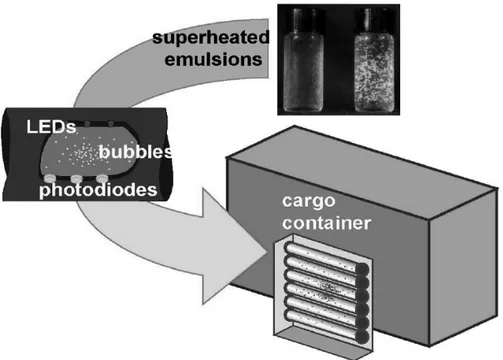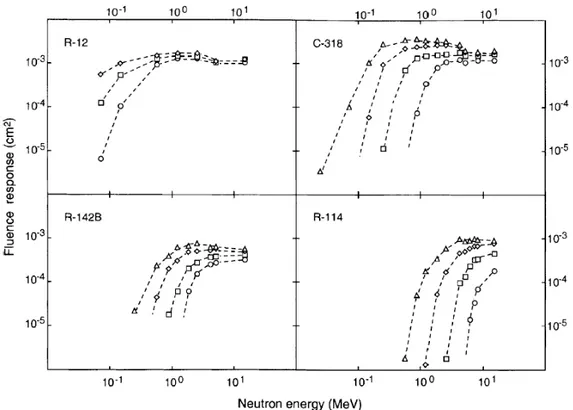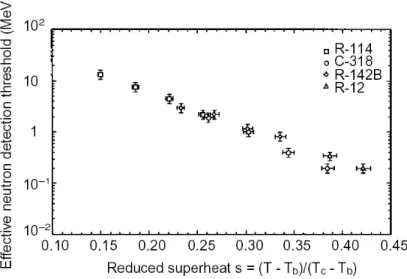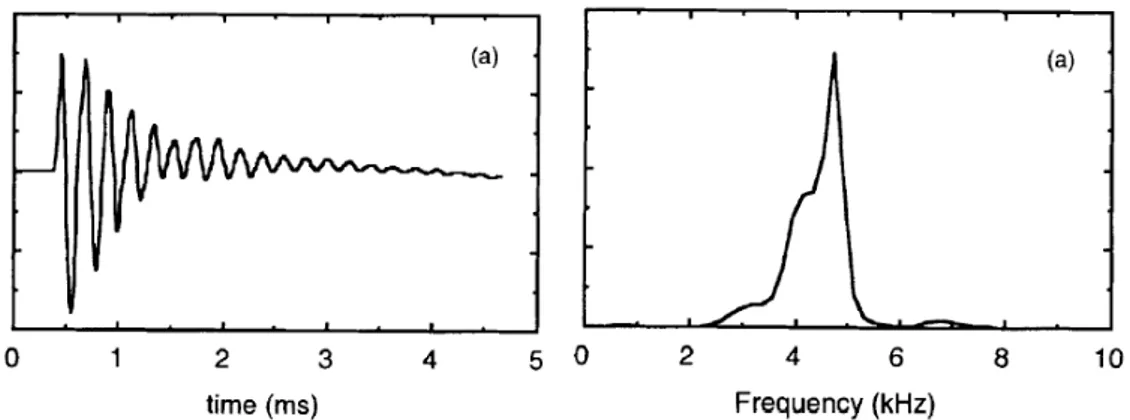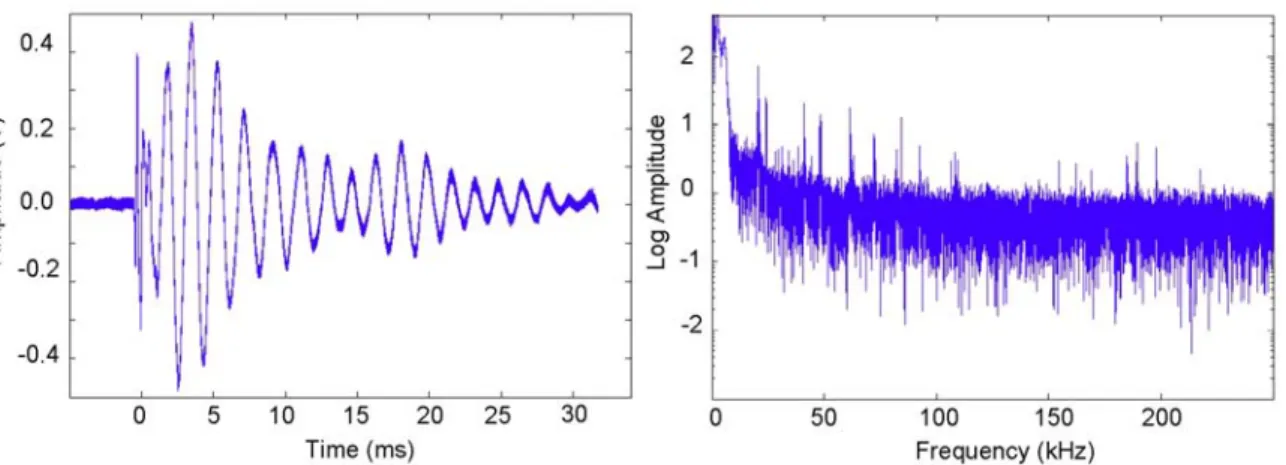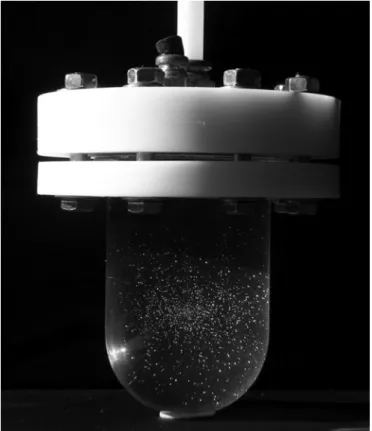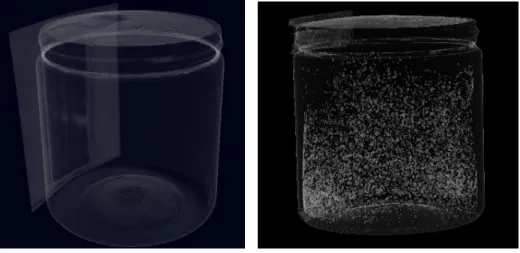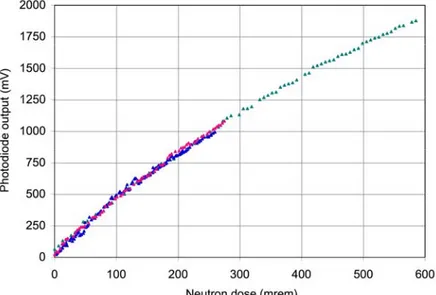Titolo
Viability of 20 neutron-sensitive superheated emulsions for active cargo
interrogation
Ente emittente CIRTEN
PAGINA DI GUARDIA
Descrittori
Tipologia del documento: Collocazione contrattuale:
Argomenti trattati:
Rapporto Tecnico
Accordo di programma ENEA-MSE: tema di ricerca "Nuovo nucleare da fissione"
Ingegneria: Ingegneria nucleare
Fisica dei reattori nucleari: Neutronica
Sommario
Il documento riguarda la valutazione della possibilità di applicazione di rivelatori di neutroni 20 innovativi. Il sistema proposto permette ilsimultaneo irraggiamento e la rivelazione della radiazione con il vantaggio di non richiedere complesse elaborazioni del segnale. Tra gli altri vantaggi si osserva un elevato rapporto segnale-rumore, l'insensibilità ai fotoni ed un apparato elettronico semplice.
Note
REPORT PAR 2008-09LPS.B2 CERSE-UNIPI RL 1088/20 Il Autori: F.O'Errico, A.Oi Fulvio
Università diPisa Copia n. In carico a: NOME 2 FIRMA NOME 1 FIRMA NOME P. Meloni
o
EMISSIONE FIRMADESCRIZIONE VISTO APPROVAZIONE
CIRTEN
Consorzio Interuniversitario per la Ricerca TEcnologica Nucleare
Lavoro svolto in esecuzione della linea progettuale LP5 punto B2
UNIVERSITY OF PISA
Viability of 2D neutron-sensitive superheated emulsions
for active cargo interrogation
Francesco d’Errico Angela Di Fulvio
CERSE-UNIPI RL 1088/2011
Viability of 2D neutron-sensitive superheated emulsions
for active cargo interrogation
The overall goal of this project was exploring the viability of superheated emulsions for the detection of special nuclear materials and related threats. The proposal builds upon the extensive experience available at the University of Pisa with the superheated emulsion technology for neutron detection and spectrometry and for position-sensitive measurements. These detectors are suspensions of superheated droplets in a compliant medium; upon irradiation with sufficiently energetic neutrons, the detectors develop a cloud of bubbles which can be recorded and later reset to the liquid state.
The system we examined would consist of large detector modules ideally suited for use in active interrogation schemes using either x-rays or low-energy neutrons (Figure 1). In fact, the detectors can be produced to be fully sensitive to prompt fission neutrons and totally insensitive to x-rays and/or to neutrons below chosen energy thresholds, e.g. any energy between 0.1 and 1 MeV. Therefore, the detectors would be able to operate while the x-ray or neutron interrogation beam is on and they would only pick up the signal from fission neutrons. Successful development of this approach would potentially transform our interdiction capabilities, allowing rapid and reliable measurements of neutrons from special nuclear materials.
The most relevant specific aspects of the investigated approach are:
• The detectors examined in this project present a sharp neutron energy threshold suitably selected to detect prompt neutrons from nuclear material fissions, while discriminating against the radiations used for interrogation purposes (either high-energy x-rays or low-high-energy neutrons). For maximum duty cycle, the system can be used with a continuous interrogation beam, possibly even while a container is moving.
• These devices are inherently sensitive to neutron recoils only, and thus offer complete photon discrimination. The device is expected to produce zero false alarms due to gamma radiation and naturally high-background cargo will no longer be an issue.
• A position-sensitive read-out mechanism can rely on either the attenuation or the scattering of light by neutron-induced bubbles. A beam of coherent light crosses the active area of the detector, and local variations in transmitted or scattered light due to the presence of bubbles can be detected in real time by arrays of photodiodes. Additionally, we investigated real-time read-out techniques based on the ultrasonic acoustical signature of bubble formations.
• The background neutron signal due to primary cosmic neutrons and to their interactions with the cargo itself can be subtracted. Primary and secondary cosmic neutrons are expected to produce a signal distributed fairly uniformly over the detector volume. A sudden increase in count rate on the detectors while a container is moving through the interrogation beam, or a higher localized density of bubble formation in the detectors, reveals a suspicious region of a cargo.
• The detector system does not require special training in order to be operated. In fact, it relies on the inherent threshold behavior and the photon-insensitivity of the detectors in order to provide a yes/no answer as to whether prompt fissions are triggered by the active interrogation of a container.
• The detector modules are renewable. By re-pressurizing the modules periodically, the distribution of signals in the detector are effectively "zeroed".
• The system may comprise redundant modules. The redundancy of the modules would permit the continuous availability of sensitive detectors even when some of them are being periodically annealed.
Scientific context and significance
Combating terrorism is among the highest priorities of the western world and a key aspect of this effort is preventing special nuclear materials from being introduced into our country, hidden in the large containers entering through shipping ports and carrying the large majority of cargo. The possible presence in these containers of weapon components containing special nuclear materials is extremely difficult to detect through their faint radioactive signature. While radiation emitted by Pu-239 may be picked up by high-sensitivity devices, that of highly-enriched U-235 (HEU) is virtually impossible to detect with passive interrogation techniques. In fact, the emission consists of an extremely low yield of neutrons and a weak emission of low-energy gamma rays which are strongly attenuated by surrounding materials. For these reasons, active interrogation techniques, whereby an external beam of neutrons or high-energy x-rays is typically used to trigger fission reactions, are considered the only viable option to detect the presence of HEU. These techniques are also effective in the detection of Pu-239, as illustrated in a comprehensive DOE Report (2002) and in the review by Slaughter et al (2003).
Historically, since the late 1960's (Keepin, 1969), active interrogation for the detection of special nuclear materials has concentrated on the detection of delayed fission-neutrons by means of moderator-type neutron detectors. These detectors can be blinded by the intense pulse of prompt gamma radiation that accompanies the fission process. In recent versions of the technique (Moss et al, 2004), a pulsed beam is used and the detectors are gated off for a few milliseconds during and after the interrogation pulse, in order to allow them to recover from saturation. After this time, the moderator-type detectors can be used effectively to record the well known delayed neutron yield (e.g. Hughes et al 1948), emitted with a half life of up to one minute after the fission. These neutrons carry a signature that is characteristic of special nuclear materials; however, both their emission energies and their yields are relatively low, which leads to a limited neutron flux emerging from cargo containers. For this main reason, an alternative approach has been developed relying on the detection of delayed high-energy gamma rays. These are produced with yields about 10 times larger than those of delayed neutrons, are not attenuated as intensely, and also carry a signature characteristic of special nuclear materials (Norman et al, 2003). The technique is effective, however, it still requires intermittent operation of the interrogation system, which alternates between irradiation and detection. For improved duty cycle, more recent active interrogation techniques have focused on the detection of prompt fission-neutrons, whose yield is over 100 times higher than that of
delayed neutrons. A relevant example relies on the use of xylene-based liquid scintillators in conjunction with a low energy neutron interrogation beam (Kerr et al, 2006). The system is highly sensitive to photons and it utilizes advanced laboratory-electronics for pulse shape analysis and for the identification of the neutron signal against the prompt fission-gamma flash.
While all these systems have unquestionable merits, this work aimed at exploring the potential of an approach that is intrinsically simpler, since it relies on the inherent ability of superheated emulsions to detect the prompt fission-neutron emission triggered by active interrogation in HEU, without the need for complex gamma discrimination techniques.
Smuggling of HEU is identified as an extremely serious threat, as it lends itself to improvised nuclear devices; HEU is also harder to detect and possibly easier to obtain than Pu-239 (DOE, 2002). The examined system would offer the possibility of simultaneous irradiation and detection, i.e. a 100% duty cycle, without requiring complex signal analysis. The system would also offer high signal-to-noise ratio, minimizing costly nuisance alarms, thanks to its inherent insensitivity to photons (either background gamma radiation, or x-ray beams when these are used for interrogation).
Background of proposed approach
Superheated emulsions
The superheated emulsion technology was originally developed in the late 1970's at Yale University (Apfel, 1979) and the ensuing pen-size "bubble (damage) detectors" greatly contributed to the increasing popularity of the technology (Ing and Birnboim, 1984).
These detectors consist of emulsions of halocarbon droplets homogeneously dispersed in a compliant matrix. The drops are in a superheated state, i.e. above their boiling point. Being metastable, the drops can be triggered to vaporize by the energy deposited through radiation interactions (Figure 2). This is the same principle of the
classic bubble chamber (Glaser, 1952), but the emulsions differ in that they are continuously sensitive to radiation since the droplets are kept in a steady superheated state.
Figure 2. Superheated emulsions before and after irradiation.
These detectors were introduced as personnel dosimeters for neutrons, but over the past three decades they have reached a level of development allowing a multitude of practical applications. Several devices based on this technology have been designed and built. Some are active counters acoustically detecting the sound pulses radiated when drops suddenly vaporize into bubbles. Others are passive integrating meters typically employed for personnel monitoring and even for in vivo neutron dosimetry of radiotherapy patients treated with high energy x-rays (d'Errico, 2001).
A wide variety of superheated emulsions containing halocarbons of different chemical composition and boiling point have been investigated for ionizing radiation measurements (d'Errico and Alberts, 1995; d'Errico et al, 1995). These studies unraveled the correlation existing between the thermodynamic and nuclear properties of the detectors (d'Errico et al, 1997; d'Errico et al, 2000). It was shown that bubble nucleation only occurs when sufficient energy is deposited within an extremely localized region of a superheated drop. The higher is the superheat of the liquid, the lower the minimum energy that must be imparted to the drop in order to nucleate the evaporation. Charged particles generate trails of microscopic vapor cavities inside the droplets, but only those exceeding a minimum critical size can overcome the surface tension in the drops and develop into bubbles.
By appropriate choice of the detector parameters, a selective response can be achieved to the different types of ionizing radiations. In particular, emulsions of dichlorotetrafluoroethane (R-114) and octafluorocyclobutane (C-318) are completely insensitive to photons and are ideal for fast neutron spectrometry as well as for the detection of charged particles above specific energy and linear energy transfer (LET) values. In fact, they require the deposition of hundreds of keV per µm and are only nucleated by high-energy heavy ions such as fast neutron recoils. Emulsions of dichlorodifluoromethane (R-12), on the other hand, are also sensitive to thermal and intermediate neutrons. These are most suitable for neutron dosimetry since their response closely matches the ICRP dose equivalent conversion factors over a broad energy interval.
The above mentioned emulsions have been successfully used for neutron dosimetry and spectrometry inside radiotherapy x-ray beams, since they are insensitive to photons.
Detector physics
Over almost two decades, we carried out extensive measurements of detector responses using broad-spectrum neutron sources, monoenergetic neutron beams up to 19 MeV and
quasi-monoenergetic beams up to 200 MeV. Between thermal and intermediate energies, monoenergetic neutron beams are not available, and numerical simulations of the response were carried out with Monte Carlo radiation transport techniques. Figure 3 reports the
responses of emulsions of dichlorodifluoromethane CCl2F2 (R-12), octafluorocyclobutane
C4F8 (C-318), monochlorodifluoroethane C2H3ClF2 (R-142B) and dichlorotetrafluoroethane
C2Cl2F4 (R-114); the responses are shown as a function of neutron energy and operating
temperature.
Figure 3. Response of small detectors of dichlorofluoromethane (R-12), monochlorodifluoroethane (R-142B), octafluorocyclobutane (C-318) and dichlorotetrafluoroethane (R-114), measured as a function of neutron energy
at 25 (Ο), 30 (9), 35 (◊), and 40 (∆) degrees Celsius.
A general trend may be immediately observed: the higher the detector temperature, the lower the minimum neutron detection threshold, i.e., the minimum energy that neutron recoil particles must transfer in order to vaporize the droplets. In order to parametrize the
experimental data, d’Errico introduced the "reduced superheat" s = (T — Tb)/(Tc— Tb), a non
dimensional quantity where Tb is the boiling temperature of the droplets and Tc their critical
temperature. The reduced superheat represents the normalized operating point of an emulsion
If we use an "effective threshold" corresponding to 70% of the plateau in the response curves, and plot results against reduced superheat, we observe the exponential correlation of Figure 4. The behavior is valid for fluorocarbons, chlorofluorocarbons, and halogenated hydrocarbons.
Thanks to its general validity, the correlation allows us to reliably predict the neutron response thresholds of superheated emulsions.
Further systematic studies of the correlation between detection properties of the emulsions and reduced superheat revealed that, above temperatures corresponding to a reduced superheat s ~,> 0.33, all chlorinated halocarbons become sensitive to thermal neutrons via the
35Cl(n,p)35S reaction. Moreover, at
sufficiently high temperatures, the emulsions become sensitive to photons. Results are extremely consistent: photon sensitization occurs for s ~,> 0.5, i.e. above the mid-point between boiling and critical temperatures of the emulsions (d'Errico et al, 1998; d'Errico et al, 2000). Emulsions presenting a reduced superheat of about 0.25, like the ones we examined in this research, are only sensitive to neutrons.
These studies demonstrated that our understanding of the superheated emulsion physics allows us to design detectors which present the desired neutron response thresholds and which are completely insensitive to photons.
Detector applications and implementations
Over the years, these studies on the physics of superheated emulsions have found practical application in the development of a variety of instruments for radiation measurements. Some of them constitute the foundations for this investigation and are briefly described hereafter.
Figure 4. Effective neutron thresholds of superheated emulsions of dichlorofluoromethane (R-12), monochlorodifluoroethane (R-142B), octafluorocyclobutane (C-318) and dichlorotetrafluoroethane (R-114)
Since the early development stages of superheated emulsions, instruments were designed registering bubble nucleations acoustically (Apfel and Roy, 1983). In fact, the rapid bubble expansion associated with the boiling of superheated droplets is accompanied by oscillating pressure pulses with a duration of up to 10 ms and with a principal harmonic of about 5 kHz (Figure 5), which can be easily recorded.
In the current design (Figure 6), a double piezoelectric transducer configuration is used for the comparative pulse-shape analysis of the detector signals against external noise (Apfel and d'Errico, 2001; Taylor et al, 2006). These signals are amplified and fed to analog circuitry for amplification, rectification, and low-pass filtering, followed by analog-to-digital conversion and sampling. A microprocessor evaluates the shape and amplitude of the signals, and if these match those of a real bubble-formation event, a pulse is counted. Thus, true vaporization events are distinguished from spurious noise both by anticoincidence and by
Figure 5. Temporal evolution and harmonic analysis of pulses emitted by vaporizing droplets
pulse shape analysis. Vibration dampers decouple the vial from the detector-case, thus improving the noise discrimination. This allows operation with ambient noise levels above 100 dB.
These detectors have been used in a variety of situations, including measurements inside nuclear power plants and on board aircraft. In particular, they were used in a NASA project during which measurements of cosmic radiation were made on board a U2 airplane flying at 65,000 ft (19.8 km). During these flights, the pressure inside the payload sections of the airplane dropped to about 0.3 atmospheres, while the temperature was as low as -15°C. A rugged version of the device was designed, built and successfully employed. The system was placed inside an enclosure which ensured an optimal operation of the superheated drop detectors at a temperature close to 30°C (d'Errico et al, 2003).
These studies demonstrated the feasibility of rugged versions of the system which operate optimally despite extreme environmental conditions. This is crucial in the development of a system for active neutron interrogation which must operate in the field all year round.
The acoustical detection of the bubbles has traditionally relied on sensors centered at 5 kHz, corresponding to the principal harmonic of the bubbles. However, recent experiments done on C-318 emulsions in collaboration with the National Physical Laboratory (UK) revealed a significant signal component between 50 and 200 kHz (Figure 7, Hodnett, 2009). Noise events do not present this high frequency component.
Figure 7. Oscilloscope waveform (left) and corresponding FFT (right) for acoustic signals from bubbles being formed in C-318 emulsions irradiated with fast neutrons.
Therefore, the use of ultrasonic acoustic circuitry in conjunction with high-frequency band-pass filtration appears to be a viable alternative to the previous procedure based on
pulse-shape analysis. The advantages of this approach are that noise rejection would be straightforward and signal processing much faster, allowing operation at higher count rates. This approach could not only provide a complementary solution to the optical readout, but also valuable information on phenomena happening at about 200 kHz, i.e. on a few-microsecond scale. These are the expected expansion times of the vaporizing droplets. Should these rapid response times be confirmed also by experiments with pulsed beams, our detector system would appear suitable for coincidence/multiplicity counting.
Another prior application of superheated emulsions relevant to this work is their use as position sensitive detectors. On-line, position-sensitive acoustical detection of bubble events based on triangulation techniques has been tried in large-volume detectors (Hamel et al, 1997), however, this is complex when the emulsions are crowded with bubbles, since multiple scattering of the acoustic waves affactes their harmonic composition and travel times. Conversely, a position-sensitive detection is possible by means of magnetic resonance or by optical tomography techniques.
Magnetic resonance techniques have been successfully applied to a detector chamber for the three dimensional dosimetry of brachytherapy sources emitting photons or neutrons (d'Errico et al, 1998; Lamba et al, 1998; d'Errico et al, 2001). In these applications, the detector contains an extremely fine suspension of droplets emulsified in a highly viscous gel. When the sources are inserted into the detector, stable bubble distributions form around them, enabling visualisation of the radiation field (Figure 8). Bubbles can be effectively imaged by slice-selective 3D gradient echo or echo planar magnetic resonance techniques. After the imaging, the detector can be pressurized in order to
recondense the bubbles to the liquid phase and can be used again for repeated measurements. A system with detector-compression/decompression and source-insertion/retrieval
Figure 8. Photograph of an irradiated 0.5 L emulsion chamber for 3D dosimetry
automatically controlled by an MRI scanner has been co-developed by d’Errico and has been reliably used for several years (Pratt et al, 2002).
These studies demonstrated the feasibility of systems whereby the detector is annealed automatically and cyclically, which can reliably operate unattended for long periods of time.
Alternatively, computed tomography based on laser beam attenuation profiles has also proven feasible. The approach of using scattered light to measure and depict bubble distributions in superheated emulsions was tried over 10 years ago (d'Errico et al, 1998), and has been resumed in recent years with the development of an opto-electronic readout scheme for application in personal dosimetry (d'Errico, 2006; d'Errico et al, 2008) and for a remotely monitored network of sensors on cargo ships (Lemley, 2005). Extensive preliminary studies were performed in which superheated emulsions were illuminated with LEDs of different
colors and the light scattered by the bubbles was recorded with photodiodes (Figure 9). A variety of light sources of different colors and photodiode configurations were tested. Our best results came from the use of red light illumination from the bottom of the detector and a configuration of planar photodiodes on the walls of the detector (spaced at 120° and recording the light scattered at 90° by the bubbles).
One of the key factors for the optimal application of the optical counting approach is the uniformity of the drop sizes present in the emulsions. Our techniques allow the manufacturing of drops of any size in the 50-150 µm range with a dispersion lower than 10% on the nominal diameter. This ensures the generation of uniform-size bubbles upon irradiation, causing a
Figure 9. Schematic of Figure 10. Linearity of response of superheated emulsion optoelectronic readout with electronic readout
smooth increment in the scattered light. Indeed, linearity and reproducibility of the response of this system were truly outstanding, as illustrated by Figure 10 (d'Errico et al, 2008).
These studies demonstrated the feasibility of a real-time optical read-out system for superheated emulsions that provides an accurate and instantaneous recording of bubble formation in the detectors. The system is completely insensitive to external noise or vibration and ideally suited for a device to be deployed in the field.
A superheated emulsion module for the detection of nuclear material
Having previously gathered extensive expertise in the superheated emulsion technology and proven that it has the potential for a high performance detector for active neutron interrogation, we examined the following system of modular design.
• The detectors are planned to be assembled inside high-strength borosilicate glass pipeline sections. Borosilicate glass is an approved and proven material of construction for pressure vessels, widely used in the chemical, pharmaceutical and allied industries. Cylindrical pipeline components with a wide range of diameters and lengths are commercially available. Initial modules can be 5 cm in
diameter and 50 cm in length. Ultimately, the detectors could be 2 meters long (or more). • The primary readout system is optoelectronic.
Silicon planar photodiodes are employed, featuring low cost, high reliability, and linear short circuit current over a wide range of illumination. Planar photodiodes also come in a large variety of models and dimensions. Initially, we examined 2.5 cm long and 0.5 cm wide models. These are affixed along the whole length of the detector, in three arrays at 120° with respect to the axis of the detector (Figure 11). The signal from each triplet of coplanar detectors is added and provides the reading
corresponding to each 2.5 cm long segment of the detector. This offers a highly efficient position-sensitive readout with a resolution of 2.5 cm, which is considered adequate for the
Figure 11. Schematic view of cylindrical superheated emulsion detector with arrays of photodiodes positioned at 120° along the entire
purpose of the system. Indeed, if longer photodiodes are found or become available, these should certainly be tried.
• Red LED sources have proven most effective in the small scale studies conducted so far. However, red light is less penetrating in aqueous media than green or blue, therefore, we should also investigate use of these two colors. The possibility should be examined of illuminating the detector cylinders from one end only or from both ends. Additionally, the possibility should be investigated of using attenuation measurements, by distributing the light sources along the cylinder, in front of the photodiodes, rather than at the ends of the detector modules.
• A further acoustical readout system is investigated. A series of high-frequency piezoelectric sensors is employed. These provide sensitivity to a part of the acoustical pulse from the bubbles which is well separated from the typical noise frequencies, thus allowing for the selective detection of bubble pulses.
• The optoelectronic and acoustical approaches are examined both as alternative and complementary (redundant) methods with the ultimate goal of ensuring efficient bubble detection even in the presence of noise and vibration (e.g. due to a moving container). • A high-viscosity gel is used for the emulsification of the superheated liquids, so that the
neutron induced bubbles remain firmly immobilized at the position of their formation. We have ample experience with the preparation of emulsions dispersed in viscous gels (including gels whose viscosity is independent of temperature) and we can formulate compositions with the required stability, optical clarity and viscosity.
• Standard high-pressure pumps and gauges are used in the annealing of the system. Remotely controlled pressurization is performed hydraulically, so that no rapid expansion of any component can occur in case of the unlikely failure of the system.
• The neutron-sensitive superheated liquids to be used for the production of the emulsions must be chosen in order to offer the following features:
− immiscibility in the gels, for maximum stability and optical clarity of the detector, − no response to photon radiation
− no response to thermal neutrons (no chlorine in the molecule), − sharp neutron detection thresholds between 0.1 and 1 MeV.
Name CAS # Formula Tb (°C) Tc (°C) Tγ (°C) Tetrafluoroethane (R134A) 811-97-2 H2FC-CF3 -26.2 100.9 40
Octafluorocyclobutane (RC318) 115-25-3 C4F8 -7 115.2 55
Perfluorobutane (R610) 355-25-9 C4F10 -1.7 113.3 57
Tb = boiling temperature, Tc = critical temperature, Tγ = photon sensitization temperature
For a detector operating temperature of 35 °C, the above mentioned liquids present effective neutron energy thresholds of ~ 100, 500 and 800 keV, respectively.
• A device to be eventually deployed in the field needs be "ruggedized" by means of an enclosure which ensures protection from both physical impact and from environmental agents. This enclosure may be easily designed to provide temperature regulation as well, stabilizing the detectors at an operating temperature between 35 and 40 °C (in this case, we should not use emulsions of R134A, which would be too close to photon sensitization), so that in most practical circumstances they will require some heating, but no refrigeration. • Devices exploiting the unique potential of superheated emulsions of the proposed size have
not yet been developed. Therefore, the ultimate determination of the detection efficiency must be performed. Based on our prior experience with these detectors, an efficiency approaching 10% is expected for fission neutrons. Our detectors have virtually 100% duty cycle and they can work with continuous interrogation beams, therefore their overall efficiency should be evaluated against other systems considering the combination of their instantaneous efficiency and duty cycle.
In our proof-of-concept work(d'Errico and Di Fulvio, 2011), we manufactured a detector of this kind: it is a 400 mL emulsion containing about one million, 70 µm drops of perfluorocarbon C-318. At an operating temperature of 25 °C, the detector has a reduced superheat of 0.26, it is sensitive to a large fraction of a fission spectrum and it is completely insensitive to photons.
The rejection of high-energy photons was verified with 6 MV X-ray irradiations at a radiotherapy accelerator. Even after a dose of 1 Gy (at a rate of 3 Gy/min), corresponding to a
fluence of over 1010 photons/cm2 no bubbles appeared in the detector. This is documented in
striking fashion by a subsequent high-resolution CT scan of the emulsion (adding 90 mGy of 120 kV X-rays): no bubbles can be seen in the scan (Figure 12). On the contrary, the same detector irradiated with 250 mrem of Am-Be neutrons presents about 5000 bubbles of ~ 0.5
mm diameter which are easily visible on a CT scan. Clearly, the detector largely exceeds the
requirement of rejecting more than 104 photons for every false neutron count.
Figure 12. Computed tomography scans of a superheated emulsion of C-318 after an irradiation with 1 gray of 6 MV X-rays (left) and after an irradiation with 250 mrem of Am-Be neutrons (right) . The neutron
irradiation was delivered using two sources in contact with opposite sides of the detector.
For these preliminary experiments, an optical read-out system was developed for the previously described 400 mL detector containing about one million C-318 droplets of 70 µm diameter (Figure 13).
Figure 13. Apparatus developed for proof-of-concept studies. From the left: board for the LED illumination of the detector, electronics for powering the LED and acquiring the photodiode output, light-tight container
The detector was repeatedly irradiated with fast neutrons, by placing two Am-Be sources in contact with opposite sides of the detector. This was done in order to check the operation of the photo-electronic read-out when bubble distributions are non-uniform, as well as to verify the absence of coalescence when high bubble densities are reached locally. Doses exceeding 500 mrem were delivered and up to 10,000 bubbles were created and recorded (Figure 14). The detector provided a smooth reproducible response, with an output of ~0.15 mV per bubble.
Figure 14. Results of repeated Am-Be neutron irradiations of a 400 ml detector containing about 1 million C-318 drops of 70 µm. The maximum measured voltage corresponds to over 10,000
bubbles.
An additional critical issue that was addressed is the annealing of the bubbles after irradiation. Annealing is performed by applying on the emulsions a pressure higher than the vapor tension of the droplets. The procedure results in the re-condensation of the bubbles to the liquid phase.
A systematic series of tests showed that recompressing the detectors immediately after irradiations of a few minutes, similar to typical interrogation times for cargo containers, a complete annealing of the bubbles can be achieved at 20 atmospheres for just 5 seconds. The value of 20 atmospheres was chosen since it can be safely withstood by the tempered glass vessels used for the development of our prototype detectors.
Therefore, we believe that the optimal usage of the detector should include a quick recompression after every cargo interrogation. A recompression time of 5 seconds appears compatible with the turn-around time of the cargos to be interrogated. Five seconds was the
minimum recompression time achievable using an available manual hydraulic pump, it is quite likely that the use of an automated system may further shorten the recompression time.
Conclusions
Our approach of 2D neutron-sensitive superheated emulsions for active cargo interrogation builds upon extensive expertise on all the aspects of the project. The individual elements have been investigated and tested thoroughly. However, the novelty and the scale of the proposed system do pose new challenges. One of the main questions to address is the maximum size of the modules that can be developed for both efficient readout and efficient operation (e.g., the larger the cylinder, the lower the maximum pressure it can withstand). The life-span of the detectors also needs to be investigated. Systems built with our technology for 3D dosimetry are still showing accurate and stable operation after several years from their construction. The liquids and gels we plan to use should provide similar properties, but this needs to be experimentally verified over the duration of the project. Likewise, as was previously mentioned, the ultimate efficiency of the system must be determined based on the final choice of parameters such as emulsified liquid, drop size distribution and operating temperature.
This investigation supports the development of new detectors that do not rely on the depleted resources of He-3 and that could potentially transform our interdiction capabilities, allowing rapid and reliable measurements of neutrons from special nuclear materials. Smuggling of highly enriched U-235 (HEU) is identified as an extremely serious threat, as it lends itself to improvised nuclear devices; HEU is also harder to detect and possibly easier to obtain that Pu-239. Active interrogation techniques are recognized as the only viable option to detect the presence of HEU. These techniques are also effective in the detection of Pu-239. The proposed system would offer the possibility of simultaneous irradiation and detection, i.e. a 100% duty cycle, without requiring complex signal analysis. The system would also offer high signal-to-noise ratio, minimizing costly nuisance alarms, thanks to its inherent insensitivity to photons (either background gamma radiation, or x-ray beams when these are used for interrogation). The detector system would not require complex electronics or special training in order to be operated. In fact, it would rely on the inherent threshold behavior and the photon-insensitivity of the detectors in order to provide a yes/no answer as to whether prompt fissions are triggered by the active interrogation of a container.
Bibliographical references
Apfel R.E. The Superheated Drop Detector. Nucl. Instrum. Methods 162, 603-608 (1979). Apfel, R.E., and d'Errico, F. A neutron spectrometer based on temperature variations in
superheated drop compositions. Nucl. Instr. Methods A476 (1-2) 298-303 (2002). Apfel R.E. and Roy S.C. Instrument to detect vapor nucleation of superheated drops. Rev. Sci.
Instrum. 54(10), 1397-1400 (1983).
Apfel R.E., Sun Y.Y. and Nath R. Transient thermal and mechanical response of water subject to ionizing radiation. Radiat. Res. 131, 124-132 (1992).
d'Errico F. Radiation dosimetry and spectrometry with superheated emulsions. Nucl. Instr. Methods B 184(1-2) 229-254 (2001).
d'Errico F. Status of radiation detection with superheated emulsions Radiat Prot Dosimetry, 120, 475-479 (2006).
d'Errico F and Alberts W.G. Superheated Drop (Bubble) Detectors and their Compliance with ICRP 60. Radiat. Prot. Dosim. 54(3-4) 357-360 (1994).
d'Errico F., Alberts W.G., Curzio G., Guldbakke S., Kluge H. and Matzke M. Active neutron spectrometry with superheated drop detectors. Rad. Prot. Dosim. 61(1-3) 159-162 (1995).
d’Errico F., Alberts W.G., Dietz E., Gualdrini G.F., Kurkdjian J., Noccioni P. and Siebert B.R.L. Neutron ambient dosimetry with superheated drop detectors. Radiat. Prot. Dosim. 65(1-4) 397-400 (1996).
d'Errico F, Apfel RE, Curzio G, Dietz E, Gualdrini GF, Guldbakke S, Nath R and Siebert BRL. Superheated emulsions: neutronics and thermodynamics. Radiat. Prot. Dosim. 70(1-4) 109-112 (1997).
d'Errico, F., Apfel, R.E., Curzio, G., and Nath, R. Cosmic radiation measurements with superheated drop detectors. In: Atmospheric Ionizing Radiation (AIR) Analysis, Results and Lessons Learned From the June 1997 ER-2 Campaign. Eds. J.W. Wilson, I.W. Jones, D.L. Maiden and P. Goldhagen. NASA/CP-2003-212155 pp. 295-309 (2003). d'Errico, F., and Di Fulvio, A. Superheated emulsions for the detection of special nuclear
d’Errico F, Di Fulvio A, Maryañski M, Selici S. and Torrigiani M. Optical readout of superheated emulsions. Radiat. Meas 43(2-6) 432 - 436(2008)
d'Errico, F., Nath., R., Holland, S.K., Lamba, M., Patz, S. and Rivard, M.J. A position sensitive neutron spectrometer/dosimeter based on pressurized superheated drop (bubble) detectors. Nucl. Instr. Methods A476(1-2) 113-118 (2002).
d'Errico F., Nath R., Lamba M., Holland S.H. A superheated emulsion chamber for three-dimensional photon dosimetry. Phys. Med. Biol. 43, 1147-1158 (1998).
d'Errico F., Nath R., and Nolte R. A Model for photon detection and dosimetry with superheated emulsions, Med. Phys. 27(2), 401-409 (2000).
d'Errico F., Prokofiev A., Sannikov A.V., Schuhmacher H. High-energy neutron detection and spectrometry with superheated emulsions. Nucl. Instr. Methods. A 505, 50-534 (2003) DOE, Report on the Workshop on the Role of the Nuclear Physics Research Community in
Combating Terrorism. DOE/SC-0062 (2002).
Flammang RW, Seidel JG, Ruddy FH Fast neutron detection with silicon carbide semiconductor radiation detectors Nuclear Instruments and Methods in Physics Research A 579 177–179 (2007)
Glaser D.A., Some effects of ionizing radiation on the formation of bubbles in liquids, Phys. Rev. 87, 665 (1952).
Hamel L.A., Lessard L., Rainville L., Zacek V., Sur B. A superheated droplet detector for dark matter search Nucl. Instrum. Methods, A. 388(1-2) 91-9 (1997)
Hodnett M. Study of high frequency acoustic signals generated by exposure of superheated drop detectors. NPL Project Report 112661/SIS11SR13901 (2009).
Hugher DJ, Dabbs J, Cahn A, Hall D. Delayed neutrons from fission of U-235. Phys Rev 73(2) 111-125 (1948)
Ing H. and Birnboim H.C. A Bubble-Damage Polymer Detector for Neutrons. Nucl. Tracks Radiat. Meas. 8(1-4), 285-288 (1984).
Jordan D.V., Ely J.H., Peurrung A.J., Bond L.J., Collar J.I.,.Flake M, Knopf M.A., Pitts W.K.,Shaver M.,Sonnenschein A., Smart J.E., Todd L.C. Neutron detection via bubble chambers. Applied Radiation and Isotopes 63, 645–653 (2005) Keepin G.R., Nuclear
safeguards research and development, Los Alamos National Laboratory, LA-4368-MS (1969).
Kerr P., Rowland M., Dietrich D., Stoeffl W., Wheeler B., Nakae L., Howard D., Hagmann C., Newby J., Porter R. Active Detection of Small Quantities of Shielded Highly-Enriched Uranium Using Low-Dose 60-keV Neutron Interrogation. LLNL Report UCRL-CONF-223845 (2006).
Lamba M., Holland S.H., Elson H., d'Errico F. and Nath R. Magnetic resonance imaging of microbubbles in a superheated emulsion chamber for brachytherapy dosimetry. Med. Phys. 25(12) 2316-2325 (1998).
Lemley J., BNL, personal communication (2005) and US Patent 7,230,250 B2 (2007).
Lim,W., and Wang C.K. One-dimensional position-sensitive superheated-liquid-droplet in-phantom neutron dosimeter. Rev. Scientific Instr. 66(2), 5442-5449 (1995).
Moss C.E. , Goulding C.A., Hollas C.L., and Myers W.L. Neutron Detectors for Active Interrogation of Highly Enriched Uranium IEEE Trans Nucl Science 51(4) 1677-1681 (2004)
Norman E.B., Prussin S.G., Larimer R.-M., Shugart H., Browne E., Smith A.R., McDonald R.J., Nitsche H., Gupta P., Frank M.I., Gosnell T.B. Signatures of special nuclear material: High-energy gamma-rays following fission, Lawrence Livermore National Laboratory, UCRL-JC-153259 (2003)
Pratt, R., Schmithorst, V., Lamba, M., Dardzinski, B., Holland, S.K., d'Errico, F., and Nath R. System for automated magnetic resonance imaging of a superheated emulsion chamber for brachytherapy dosimetry. Rev. Sci. Instruments 73(6) 2417-2421 (2002).
Slaughter D, Accatino M, Bernstein A, Candy J, Dougan A, Hall J, Loshak A, Manatt D, Meyer A, Pohl B, Prussin S, Walling W, Weirup D. Detection of special nuclear material in cargo containers using neutron interrogation LLNL Report UCRL-ID-155315 (2003)
Taylor C., Montvila D., Flynn D., Brennan C., d'Errico F. An acoustical bubble counter for superheated drop detectors Radiat. Prot. Dosim., 120(1-4) 514-17 (2006).
Zacek V. Search for dark matter with moderately superheated liquids Nuovo Cimento A. 107A(2) 291-298 (1994).
